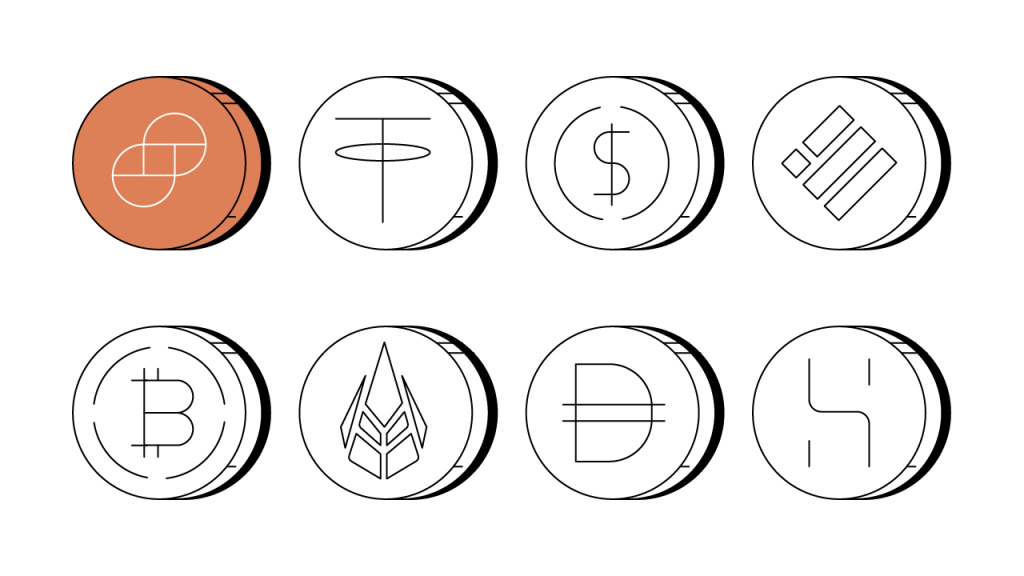Contents
Stablecoin Regulation Explained
This article breaks down stablecoin regulation, from reserve rules to real-world laws. Stay ahead in crypto with secure, regulated stablecoins.
Updated April 9, 2025 • 5 min read

Summary
Stablecoins have seen significant growth and adoption in the crypto space. However, with newfound growth comes extra scrutiny. In recent years, stablecoins have become essential building blocks in the digital asset ecosystem. From facilitating faster cross-border payments to enabling decentralized finance (DeFi) protocols, these digital tokens are designed to offer the reliability of fiat currency with the flexibility of blockchain technology. But as billions of dollars flow through stablecoin networks, regulators have had to step up to ensure these tools are safe, transparent, and accountable. Understanding stablecoin regulation is more than just knowing the rules — it's about recognizing how it impacts your crypto strategy.
What Is a Stablecoin?
A stablecoin is a cryptocurrency that supports value stability through assets pegged to reserve components, often fiat money such as USD. Stablecoins aim to maintain price stability by pegging their prices to traditional currencies, whereas Bitcoin and Ethereum can show significant price volatility.
Two methods can provide stability to stablecoins. First, the coins are backed by assets through collateralization, and second, their supply is automated according to user demand. Blockchain features stablecoins’ transparency, which provides crypto users with a blend of traditional currency confidence and blockchain efficiency.
What Are the Types of Stablecoins?
Stablecoins can generally be categorized into three main types based on how they maintain their value:
Fiat-Backed Stablecoins: These are pegged to a fiat currency, such as the U.S. dollar, and backed 1:1 by reserves held in a bank. Examples include USDC and GUSD.
Crypto-Backed Stablecoins: These are backed by other cryptocurrencies and are often overcollateralized to account for price volatility. DAI is a leading example.
Algorithmic Stablecoins: These use smart contracts and algorithms to control the stablecoin supply and maintain the peg. FRAX is a notable example.
Each design strategy represents a distinct approach. However, stability is the primary goal of all three options.
What Are Some Examples of Stablecoins?
Stablecoins come in different forms and structures. Let’s take a look at some of the most well-known stablecoins:
USD Coin (USDC)
Issued by Circle and backed 1:1 by U.S. dollar reserves, USDC is widely known for its transparency and reserve attestations. Monthly reserve attestations and collaborations with leading financial institutions have made USDC a trusted option for businesses and users alike.
Gemini Dollar (GUSD)
Developed by Gemini, GUSD is designed to operate under applicable regulatory frameworks and prioritizes transparency and full-dollar reserve backing. It’s a stablecoin designed with trust in mind, offering users a secure and transparent way to access digital dollars.
GUSD is audited monthly by an independent accounting firm, setting a high bar for stablecoin transparency.
Tether (USDT)
As the most traded stablecoin by volume, Tether has a significant presence in the crypto market. That said, it has faced scrutiny over its reserve transparency and past legal challenges. While USDT maintains a 1:1 peg to the dollar, critics argue for more consistent and clear disclosures.
Other Examples
There are many more examples of stablecoins, including:
DAI: The MakerDAO protocol manages this decentralized stablecoin, which is stable through crypto-collateralization.
FRAX: FRAX uses three mechanisms to maintain stability — supply control, collateral asset management, and pricing algorithms.
TrueUSD (TUSD): Offers real-time on-chain proof of reserves.
These stablecoins exhibit diverse features and applications, but they all maintain a stable value.
Unlock the future of money on Gemini
Start your crypto journey in minutes on the trusted crypto-native finance platform
Why Have Stablecoins Become More Regulated?
As stablecoins have grown in popularity, regulators have been paying closer attention.
Here's why:
Rapid Growth and Popularity
The market for stablecoins has quickly expanded in the last few years, making them more important for financial transactions, DeFi protocols, trading markets, and other payment solutions.
Stablecoins have reached market capitalizations in the hundreds of billions of dollars in recent years which has led financial watchdogs to observe them more closely.
Combatting Illegal Activity
The rapid growth of stablecoins has raised regulatory concerns around potential misuse, including money laundering or illicit finance. Regulatory authorities have taken measures to protect stablecoins from these kinds of misuse.
Aligning With Other Financial Regulations
Stablecoins are designed to function as electronic versions of regular fiat money. As such, many regulators believe that traditional financial standards — such as reserve management, licensing systems, and consumer protection requirements — should be applied to them.
How Are Stablecoins Regulated?
Now that you know why regulators are stepping up their game surrounding stablecoins, here’s exactly how they’re doing it:
Reporting and Licensing
Stablecoin issuers may be required to obtain specific authorizing licenses to operate. To meet the standards set by the market's existing financial systems, stablecoin issuers must follow Know Your Customer (KYC), Anti-Money Laundering (AML), and data privacy standards.
Regulations like these can facilitate greater institutional participation. Many financial firms are more likely to adopt or support stablecoins that meet defined regulatory criteria, particularly when they offer predictable compliance frameworks and legal protections.
Liquidity
Regulated stablecoins are also often required to maintain a high liquidity level. This ensures that users can redeem their stablecoins for fiat currency at any time, preserving trust in the peg.
High liquidity also helps mitigate the risk of price slippage during periods of high market volatility, ensuring smoother transactions and improved market stability.
Reserves
Transparency in reserve holdings is another top priority. Most regulatory frameworks require stablecoin issuers to hold equivalent or greater reserves in highly liquid, safe assets like cash or short-term U.S. treasuries.
Sound reserve management practices may help protect users, enhance institutional confidence, and encourage broader adoption by traditional financial players.
Transparency
Lastly, audits and regular disclosures are key. Reputable issuers like Gemini publish monthly attestations from independent auditors, providing users with clear insight into the backing of their stablecoins. This transparency fosters greater trust and broader adoption.
Clear reporting also helps regulators and users monitor risks in real time, enabling fast responses to potential issues and supporting the resilience of the crypto ecosystem.
What Are Some Examples of Stablecoin Regulation?
Different countries maintain distinct regulations regarding stablecoins, assessing potential risks based on their fiscal preferences and tolerance levels.
European Union (EU)
The EU adopted the Markets in Crypto-Assets (MiCA) regulation in 2023. This law requires stablecoin issuers to register and provide details of their reserves. MiCA aims to introduce consistent regulatory standards across all EU nations.
Hong Kong
Hong Kong’s Monetary Authority has created exclusive licensing requirements for stablecoin issuers, concentrating on proof of reserve funds and controlling operational dangers. This effort prioritizes user protection measures as Hong Kong aims to establish itself as a global cryptocurrency hub.
Singapore
Singapore's Monetary Authority (MAS) has also created regulatory standards for stablecoins, which require complete reserve support, redemption options, and strict execution safety measures. Through MAS, the Authority intends to encourage innovative approaches without creating major vulnerabilities.
United States
The United States has yet to establish a comprehensive stablecoin law. However, there are ongoing discussions regarding potential legislation.
The U.S. Congress has evaluated new legislation to establish stablecoin regulations that combine licensing requirements, mandated 1:1 reserve backing, and third-party audit responsibilities. For example, the Clarity for Payment Stablecoins Act was introduced in 2023 as a potential federal bill.
How Can Users Prepare for Stablecoin Regulation in the U.S.?
While it remains unclear if or when the United States will adopt more thorough stablecoin regulations, users can prepare by:
Choosing stablecoins that disclose audits and reserve transparency
Sticking to regulated platforms like Gemini, which prioritizes compliance
Staying informed about pending legislation in your region.
Following these best practices can help you feel more prepared if regulations are introduced.
What Are the Benefits of Regulated Stablecoins?
As stablecoins become more integrated into global finance, the benefits of strong regulatory frameworks have become increasingly evident. Regulatory clarity helps protect users and encourages broader adoption and innovation across the crypto space.
Other benefits include:
Investor Confidence: Clear rules and transparency reduce uncertainty and attract more users.
Mainstream Adoption: Regulation encourages participation from financial institutions, fintech companies, and payment providers.
Lower Risk: Strict audits and full reserve backing better protect users against de-pegging or insolvency events.
Wider Use Cases: A regulated framework enables wider use in lending, remittances, and payroll with reduced regulatory friction.
As you can see, regulated stablecoins don’t just benefit governments — they can benefit users, institutions, and regulators alike.
Wrapping Up
Stablecoins serve as a vital link between the crypto economy and the traditional world of finance. Multiple factors make stablecoin regulations important, as they preserve user trust while securing ongoing stability as adoption speeds up.
Implementing transparent oversight systems promotes measurable safety improvements for users and institutional participants. Selecting stablecoins from well-regulated platforms is essential when embarking on your crypto journey.
Ready to explore trusted, regulated digital dollars? Sign up with Gemini and discover how GUSD can bring transparency and stability to your wallet.
GUSD is issued by Gemini Trust Company, LLC, a New York Trust Company regulated by the New York State Department of Financial Services. Cryptocurrency products are not insured by the FDIC or SIPC and may lose value.
Cryptopedia does not guarantee the reliability of the Site content and shall not be held liable for any errors, omissions, or inaccuracies. The opinions and views expressed in any Cryptopedia article are solely those of the author(s) and do not reflect the opinions of Gemini or its management. The information provided on the Site is for informational purposes only, and it does not constitute an endorsement of any of the products and services discussed or investment, financial, or trading advice. A qualified professional should be consulted prior to making financial decisions. Please visit our Cryptopedia Site Policy to learn more.

Is this article helpful?


